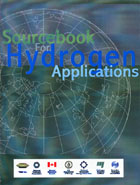
 Enter HyVIEW™
Enter HyVIEW™
Quick Links
| Why Hydrogen?Energy System ChallengesThe Perfect Fuel?What's Happening?Who can Help? |
Perfect Fuel
How Can Hydrogen Help?
To eliminate the human contribution to both the greenhouse effect and urban pollution we need a new clean energy based on renewable sources. To accomplish this, we need a new fuel and new ways of using it. Over the last 150 years, the trend in energy use has been toward reducing carbon consumption and increased use of hydrogen. Each dominant fuel, from wood to coal to oil and, perhaps, to natural gas, has contained more and more hydrogen and less and less carbon. Each successive fuel has been cleaner and more powerful.
The better environmental efficiency of our fuels has, however, been completely offset by the growth in energy consumption worldwide, which can only accelerate as the standard of living increases in the emerging economies of China, India and others.
This clean energy can be found by following the trend to its natural limit and using pure hydrogen, a fuel with zero carbon content. Regardless of how much we use it, hydrogen will not produce the pollutants that have progressively degraded our environment in the past. Hydrogen has many potential energy uses, including powering non-polluting vehicles, heating homes and offices, and fueling aircraft. City buses, automobiles and mining equipment are some proposed mobile applications that have progressed to demonstration. Home generators and large electrical generating systems represent emerging stationary applications.
In short, hydrogen has many applications and advantages. However, widespread use will require new ways to distribute hydrogen from the producer to the end user, fueling stations and many other new technologies, concepts and support facilities.
The Perfect Fuel?
Except for cost, hydrogen seems like a perfect fuel. The by-products of hydrogen combustion are electricity, water and heat. Although its low density makes efficient storage difficult, hydrogen has the largest energy of combustion per unit of mass. Energy conversion devices using hydrogen are highly efficient and produce very little or no harmful emissions.
As an energy carrier, hydrogen can be produced safely and abundantly from diverse renewable resources such as hydroelectricity, in addition to solar and wind power. Since many of these are domestic sources, hydrogen can help decrease the dependence of nations on others for fuels, eliminating the political polarizations that arise from cartel pricing, conflicting ideological and economic policies and international hostilities. For the same reasons, hydrogen can join electricity as the foundation for a globally sustainable energy system using renewable energy.
Combustion of hydrogen in internal combustion engines causes the formation of nitrogen oxides, which are produced at temperatures above 1300ºC. However the PEM fuel cell, which operates at much lower temperatures, does not produce nitrogen oxides and constitutes a perfectly clean energy conversion device. As far as the fossil fuels we use today are concerned, their reserves are finite and will run out one day. New ones may be found, but they will be more difficult to extract, driving their cost upwards. Furthermore, this finite supply of hydrocarbons is crucial to our economy as lubricants and synthetic materials, among others.
Why burn such useful chemicals? The negative environmental impact of hydrocarbon fuels has lead California to decree that by 2003, zero-emission vehicles (ZEV) must number 10% of an automaker's total vehicle sales. State regulations became the incentive that has lead to remarkably innovative vehicle technologies, the most promising of which is the hydrogen fuel-cell car.

